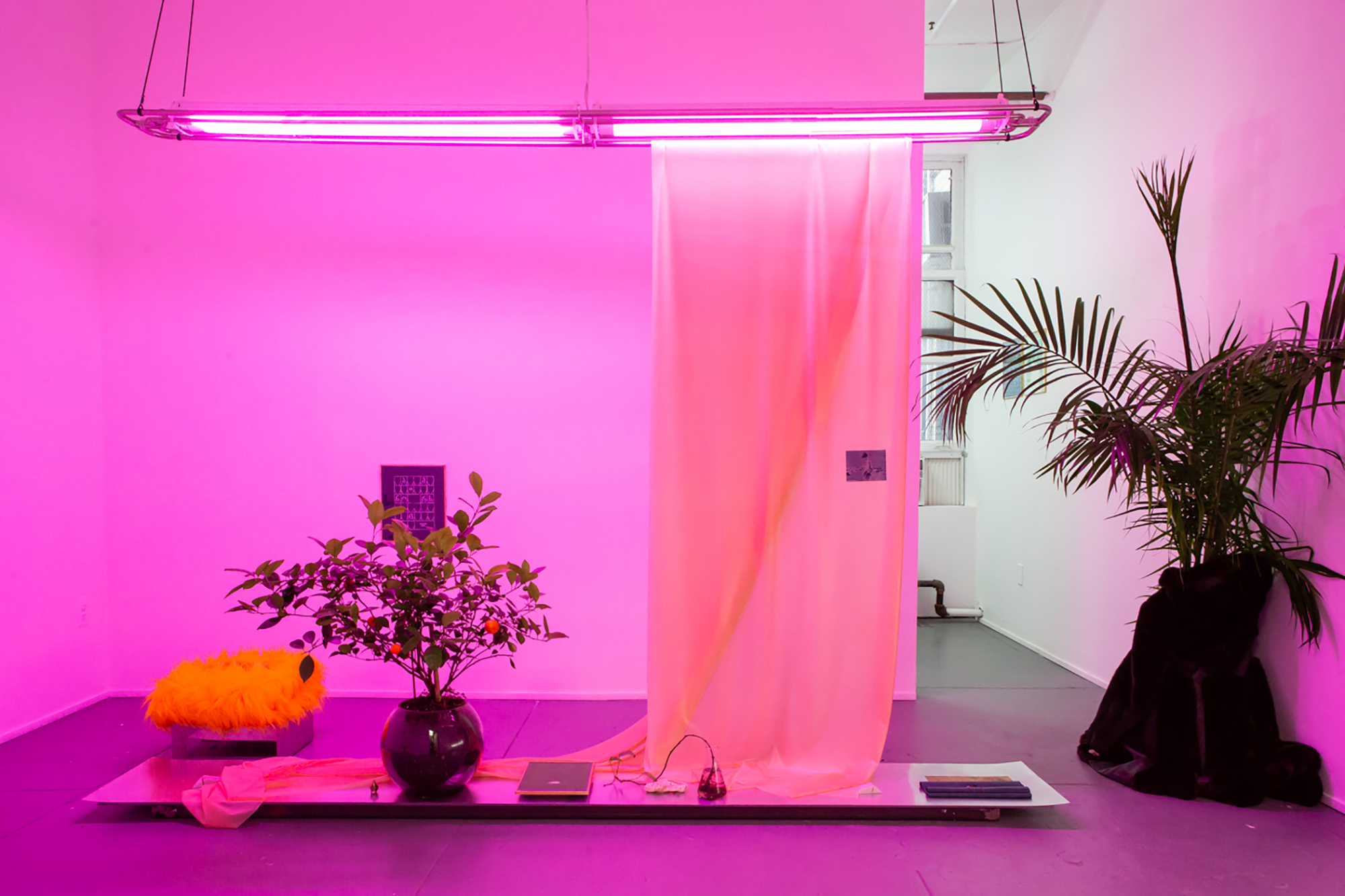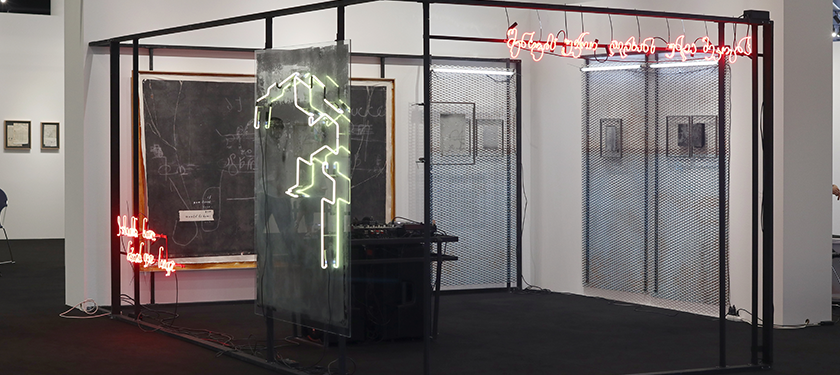
Conversations | Bel Falleiros and Levan Mindiashvili
The IAP artists talk about the importance of public art and the impact of the pandemic in their creative practice.
Art belongs everywhere, but it is in public areas that art can most radically make its way to an egalitarian audience, where it is made available outside of traditional museums and gallery spaces. NYFA spoke with artists and alumni of the 2020 Immigrant Artist Mentoring Program (IAP), Levan Mindiashvili and Bel Falleiros about how their work intersects with the public, as well as their creative processes throughout the pandemic.
NYFA: How has your practice been impacted by the pandemic, and how are you feeling about making art these days?
Levan Mindiashvili: While talking about the pandemic, first and foremost, I feel the need to acknowledge the grief and sorrow for so many lives lost, primarily because of the lack of care and willingness of the ones in power whose primary responsibility was to protect them. This grief and powerlessness, along with the healing power of care and togetherness that I experienced at the protests, were the final catalysts for me to clearly see the residues of my colonized past and the urgency of finally liberating myself from them. I got a vivid sense of the physical time and the place where I am right now; its historical context and relationship to what we call life. The pandemic has also revived my first-hand experiences of witnessing the collapse of the Imperial regime, curfews, and the lockdowns at the age of eight, so it really gave my work the purpose and the meaning I didn’t feel it had before. I’m hopeful while observing the growing disengagement from the myths and the power roleplays of the capitalist art world, which inevitably will make the alternative models possible. To reveal these deeply rooted residues of coloniality (a term coined by Dr. Madina Tlostanova) and its relationships with the crumbling patriarchy is one of the main subjects of my current work.

Bel Falleiros: I had exhibitions, and both teaching and residency commitments postponed and canceled because of the pandemic. When we were all asked to stop, I had to reorganize myself financially and administratively (especially with my family being affected by COVID in Brazil). But I embraced that call to stop and made space for silence, reflection, and grieving. It felt necessary to prepare for the changes that we were about to experience and be ready to shift from the inside out to respond to the moment and its aftermath. I am grateful I had time and space to do it. As a result of this reflection, the collaborative and community-oriented aspect of my practice gained more breath, strength, and priority. Making art just for one’s self-interest already didn’t feel right for me and the collective experience of going through a global pandemic only emphasized this feeling.
As we all adapted to a more “virtual” world, I began to work more in collaborative, online projects. I started volunteering at Escuelita en Casa, a program for art classes and school tutoring for immigrant children in Corona, Queens (thanks to Gianina Enriquez and Niceli Portugal). At that point, Corona was the epicenter of the pandemic and Escuelita en Casa responded with other related programming, like a food pantry at the Queens Museum where I also volunteered. Later, Escuelita expanded to other countries in the Americas. This opportunity to work remotely also allowed me to reconnect to projects in my home country, Brazil. Since the beginning of the pandemic, I’ve been collaborating with Renata Cruz, an artist friend there, and we’ve worked on projects related to art, education, and autonomous thinking. We are about to install a show in my hometown, São Paulo, part of a series of gatherings, opening on July 3rd at Casa Contemporanea.
Making art these days feels like a more integrated practice, a “whole package.” It is about bringing care, nurturing, and grounding to every level of the practice and the people around it. And that can manifest in many ways: beautiful artwork, breathing exercises during art class with kids, or honest conversations with peers about the art world and its traps. Inspired by a recent article from Robin Wall Kimmerer, I’ve been thinking a lot about how to cultivate an abundant environment in a capitalist system that operates on scarcity. Abundance meaning there is enough for everyone if we support each other, and I believe that is possible in art. Like in nature, in symbiotic collaborations, we can thrive together. Like Kimmerer would put it, “All flourishing is mutual.” And I believe we would all gain, artists and the public, from a more abundance-driven art world.

NYFA: Both of you have made work grounded in or engaging with public space and the ideas that constitute it. Can you speak more about this?
LV: Because of purely survival instincts, I have disassociated from my surroundings from the early years of my childhood. It was only much later, in my early twenties, when I started to get a sense of reality and myself as a physical being. That mostly happened thanks to the fact that I discovered electronic music and started to go out to dance. The dance floor felt like a safe place for me to come out to the public and become a social being. That makes me think that it’s interesting that in my native country of Georgia, dance has been historically a form of political activism. Every protest on the streets would end up with people dancing—so for me, this sense of a collective body and the shared communal joy or discontent is something innately familiar. This is why the Queer Liberation March last year was the best pride event I’ve ever experienced. It’s so powerful to hold and share the space with other bodies or make these experiences possible. My solo presentations I should Have Kissed You Longer (TAF’19 Tbilisi, Georgia) with the soundscape by Sophia Saze, and Levani’s Room: HOME (SPRING/BREAK Art Show NY, 2020) featuring the parties, mailing lists, and venues of Brooklyn’s underground queer rave scene, were my way of honoring and sharing these spaces. So I’m particularly excited about my upcoming project as a Socrates Sculpture Park fellow this year. Responding to the central theme “sanctuary,” my work will become a platform for community events and parties.
BF: For me, my practice always had the public space as its main goal. It is in the origins of art to exist in the public realm as a shared experience. Like Cecilia Vicuña once said to me while answering a question during a public talk, “All art should be public. In ancient cultures that don’t have the word ‘art’, art is public, art is made by everybody, and enjoyed by all,” and it is up to us to take it out of the “captivity” of the art world, as she would put it. So, art in the public space for me starts by trusting we can all make art that’s worthy of others’ engagement. I started making art from the discomfort with the distance between what is manifested in public space, like monuments, from those who inhabit those very same places day-to-day, and all their stories that remain silenced or unknown. I believe that creating art in the public space is to make space for this reconnection (that can happen in sculptures, performance, ritual, sound installation…), and make space for belonging again.

NYFA: What’s a project you’re working on right now that excites you?
LV: I have two large-scale projects coming up in early October, both in New York. As I mentioned, I’m excited to work with an incredible group of fellows and the staff of Socrates Sculpture Park. The second project is for Bronx Calling — a bi-annual group show at The Bronx Museum of the Arts. For this exhibition, I am re-visiting what color is the Black Sea?. First shown at Marisa Newman Projects (March-May 2021), this work was an immersive room—psychogeography of sorts. This time, it will become a large freestanding sculpture—a materialized and distanced trauma—with the possibility of new elements and interrelationships.
BF: As part of the collaboration with my artist friend in Brazil (her name is Renata Cruz), we are about to start a training program for public school art teachers in the North of Brazil. We will have around 30 teachers, each one of them working with over 60 kids—a multiplication of what started as a very humble idea in 2020. Thinking again about ecosystems, collaboration, and abundance, this project is a “pandemic” dream come true for us.
Go to NYFA’s IAP Discord for the full conversation with Falleiros and Mindiashvili, where you can learn more about how words and letters feature prominently as framing devices for their art and what it takes to adapt to another country’s art world as an immigrant artist.
About Bel Falleiros:
Bel Falleiros is a Brazilian artist whose practice focuses on land, belonging, and building space for connection. Starting with her hometown, São Paulo, she has worked to understand how contemporary landscapes, the city tissue, and its monuments (mis)represent the diverse layers of presence that constitute a place. Walking is core to her practice and fundamental to her first solo show at Caixa Cultural São Paulo, as well as to her residency at the Sacatar Institute in Bahia, Brazil (2014). Since arriving in the U.S., she has worked to create spaces for grounding and connecting people, including a site-specific installation at Pecos National Park, New Mexico (2016); an earth-work at Burnside Farm, Detroit (2017); sculptures for the garden of Tewa Women United, at the SFAI Equal Justice Residency (2018); and a brick “monument” at Socrates Sculpture Park (2020). Beyond her studio practice, she participates in collaborative projects across the Americas connecting art, education, and autonomous thinking. She is currently a More Art Engaging Artist Fellow in New York and a teaching artist at Dia:Beacon.
About Levan Mindiashvili:
Levan Mindiashvili is a Georgian-born Brooklyn-based visual artist. He holds his BFA from Tbilisi State Academy of Arts (2003), and MFA from Buenos Aires National University of Arts (2010). His work has been shown at the East Slovak Gallery, Kosovo; Elizabeth Foundation for Arts Projects Space, New York; Shau Fenster, Berlin; BRIC Arts Center, Brooklyn; National Museum of China, Beijing; Georgian National Museum; among others. His recent solo presentations were held at Marisa Newman Projects, SPRING/BREAK Art Show, New York; NARS Foundation, Brooklyn; NADA Miami; Tbilisi Art Fair ’19; and Berlin Art Fair ’19. He is a Socrates Sculpture Park 2021 Fellow, a NYFA Immigrant Artist Mentoring Program alumnus (2020), and a recipient of the Peter S Reed Foundation Grant (2020), Creative Time X Summit grant (2019), AIM Fellowship of the Bronx Museum of the Arts (2019), and of the National Endowments for the Arts (2014). His work has been mentioned in publications such as frieze, Art in America, Hyperallergic, OSMOS Magazine, Artnet News, The Art Newspaper, ArtAsia Pacific, Observer, Huffington Post, Art Margins, among others. His works are in public collections of The National Museum of Art of China, Beijing; Georgian National Museum, Mestia; State Silk Museum, Tbilisi, Georgia.
– Interview conducted by Kyle Lopez, Program Associate
This post is part of the ConEdison Immigrant Artist Program Newsletter #140. Subscribe to this free monthly e-mail for artist’s features, opportunities, and events, including our next open call for the Immigrant Artist Mentoring Program. Learn more about NYFA Immigrant Artist Mentoring Program.
